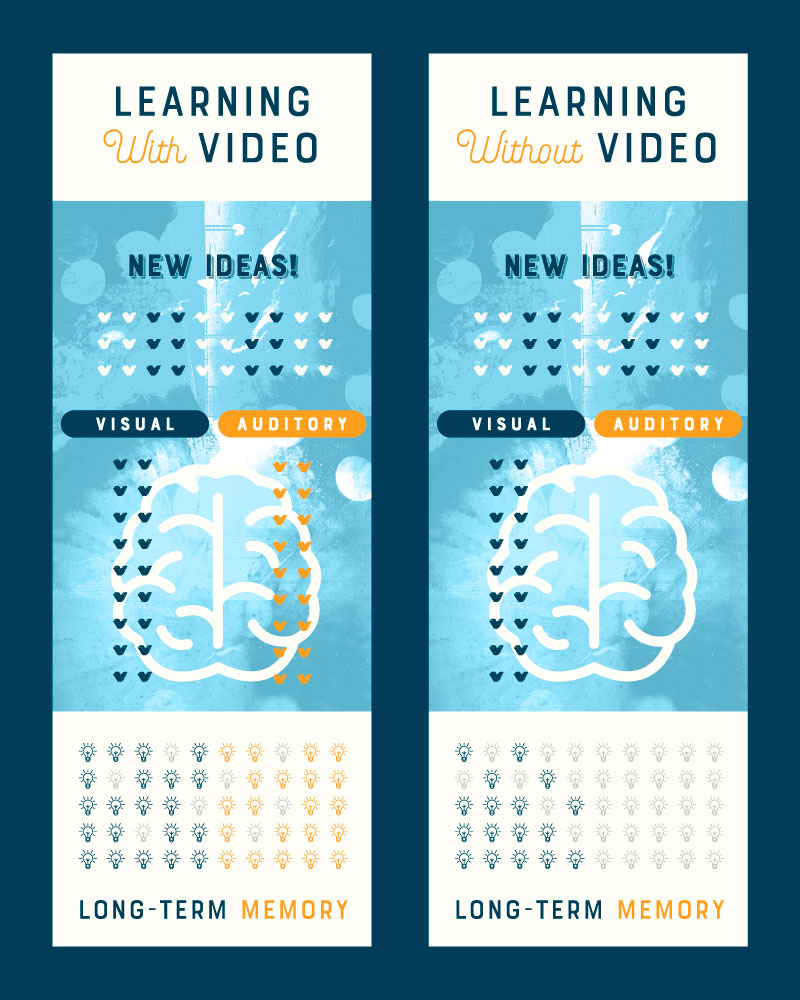Thomas Edison declared in just 1913 that “It is possible to touch every branch of human knowledge with the motion picture.” Today, video is doing just that. 100 million internet users watch videos online every day. In the corporate world, 75% of executives report watching work-related videos daily. Edison correctly predicted that video has the potential to transform the way we learn. The use of video in education has been shown to enhance learners’ engagement and retention. We believe that video just might be the most effective tool for learning. Here’s why.
Practical benefits to using video
There are three practical reasons why video improves learning:
- Access
- Control
- Emotion
Access
One virtue of video is that it can be viewed anytime, anywhere. Sal Khan, founder of the successful learning platform Khan Academy, says that this aspect of video greatly assists learners. The simple fact that video can be watched in the intimacy of one’s home, at whatever time is most convenient to the learner, can make a huge impact on the learner’s engagement. Video’s accessibility allows it to be adapted to serve the needs of every learner.
Learning works differently for every person. While some might learn best in an office or classroom early in the morning, others might feel more comfortable and engaged learning late at night in their own rooms. Although watching videos wherever, whenever might not be an option for all learners based on their unique constraints (they could be hourly employees required to go through lessons at work, have technology limitations, etc.), it is important to know that flexibility is one of video’s greatest strengths. This flexibility gives learners the space to engage with the material in the way that works best for them—boosting their engagement and retention.
Control
Video learning is self-paced. The use of video gives learners the ability to pause, stop, rewind, and repeat lessons. This helps to individualize the learning experience. While some learners might process concepts quickly, others might need more time to comprehend certain ideas. Video learning breaks the “one-size-fits-all” model that learning normally takes on. Video’s self-paced style allows for the customization of lessons, which aids learner retention.
Emotion
Video has the incomparable ability to evoke emotion. Because video can appeal to a wider range of our senses than text is able, it can elicit stronger emotional responses from viewers. Combining audio and visual elements has the power to create dramatic appeal. Inciting an emotional response improves the learning experience, as it improves the engagement of the viewer and gives him a stronger memory of the message presented.
Science affirms video’s capabilities
Scientific findings have backed these practical reasons behind the power of video. Psychologist Dr. Richard E. Mayer’s Cognitive Theory of Multimedia Learning (CTML) explains how retention and engagement are improved by video learning because of the way our brains are wired. Essentially, by looking at the way our brains process information, this theory confirms that we learn better from video than from text alone. Our brains retain more new information in our long term memory when the information is presented through visual and auditory mediums, rather than just through words on a page.
Here’s the way it works:

Our brain has two channels that process new information: the visual channel, and the auditory channel. These are essentially two funnels that exist in our brains to process new information and transfer it to long-term memory. Unfortunately, we all have a limited capacity to process information that is new to us. Because of this, our brains never retain all of the new information in our long-term memory. Instead, our auditory and visual channels “digest” the new information and store only the pieces which we remember the strongest.
When we are presented with new information as text, we are using only the visual channel. This channel “digests” the information and puts the parts which we remember the most in our long-term memory for safe-keeping.
However, when we are presented with new information in a video, our brain “digests” the information with both our auditory and visual channels. Because each of these channels are being used to process information and pick out the strongest segments to place in long-term memory, we end up with more information being transferred to long-term memory than had we only used our auditory channel. And the more we fill up our long-term memory boxes, the more we learn!
Not all videos are created equal
Not all videos will equally enhance the learning experience. Video learning must be done right in order to optimize learner retention and engagement. Four pieces of advice for creating the most impactful video can be extracted from the practical and scientific strengths of video learning:
- Simplicity
- Length
- Signaling
- Targeting
Simplicity
Video learning has the ability to simplify complex ideas by presenting them in a way that makes them easy to understand. However, adding elements to a video which don’t serve a purpose may distract the learner and weaken video’s power to simplify. Images, text, or background music which don’t substantially contribute to the lesson being communicated will create clutter. This takes away from the amount of actual information that is digested by the learner. The most impactful videos are simple and intentional.
Length
Studies have shown that learners’ attention spans when watching a video do not last more than 6-9 minutes on average. To ensure that learners are able to retain information from the entire video, it’s best to keep educational videos short. Longer lessons may require multiple videos to be made which segment the lesson into easily-digestible bits. Effective educational videos do not last longer than our attention spans permit.
Signaling
Signaling helps to make sure learners retain the most important ideas from a lesson when processing the new information. This means visibly or audibly pointing out which information is most important to remember. Signaling can be done by visually enlarging text which displays a main idea, or by audibly emphasizing and repeating important information. This helps learners organize new information and ensures that the main ideas of the lesson will stick after the brain is finished “digesting”.
Targeting
As shown by the CTML, video is impactful because it targets both our auditory and visual channels for information processing. Therefore, it is important when creating a learning video to ensure that both these channels are being put to use. A video of an individual lecturing or talking through a lesson fails to fully take advantage of our visual channel. Similarly, a video which consists only of text on a screen played with background music fails to take full advantage of our auditory channel.
In order to optimize both of these channels, the auditory and visual elements of a video must contribute to the substance of the lesson. For example, painter Bob Ross’ method of explaining how to paint an elaborate mountain landscape while he executes this scene himself successfully takes advantage of the viewer’s auditory and visual channels. Indeed, he has successfully helped to train millions of aspiring artists. Targeting is key to making a learning video the most impactful it can be.
Thomas Edison had it right
Today, it is clear that video has the power to remold the way we learn. Video offers a learner-centric take on education which enhances engagement and retention. We think it’s time to embrace this transformation.
